Abstract
This study aimed to determine the relationship between the metabolic and endocrinological pathologies in polycystic ovary syndrome (PCOS) and the levels of arsenic, chromium, cadmium, lead, mercury, antimony, zinc, and copper to evaluate the relationship of these toxic metals with inflammatory/oxidative parameters. This study included a total of 154 patients (84 with PCOS, 70 healthy volunteers). Metabolic and endocrine parameters and arsenic, chromium, cadmium, lead, mercury, antimony, zinc, and copper serum levels of the patients were compared between the groups. Considering the action mechanism of toxic metals, serum malondialdehyde (MDA), superoxide dismutase (SOD), serum total antioxidant status (TAS), total oxidant status (TOS), oxidative stress index (OSI), tumor necrosis factor-alpha (TNFα), and high-sensitivity C-reactive protein (HsCRP) levels were determined. Serum TAS (p = 0.002), OSI (p = 0.006), SOD (p = 0.006), zinc (p = 0.010), and copper (p = 0.030) values were statistically lower whereas TOS (p = 0.008), MDA (p < 0.001), HsCRP (p < 0.001), TNFα (p < 0.001), antimony (p < 0.001), cadmium (p < 0.001), lead (p < 0.001), and mercury (p < 0.001) levels were significantly higher in the PCOS group than those determined in the control group. Antimony was positively correlated with fasting glucose (FG) and HOMA-IR while cadmium, in addition to FG and HOMA-IR, positively correlated with insulin and lead had a positive correlation only with FG (p < 0.05). Also, these three heavy metals correlated positively with some oxidative system and inflammatory parameters and negatively with the antioxidant system parameters (p < 0.05). In conclusion, heavy metal exposures in PCOS may be related to insulin resistance and hirsutism through oxidative and inflammatory mechanisms. This approach can be used to identify the risky patient group and to develop new treatment modalities.


Similar content being viewed by others
Change history
20 November 2020
The original version of this article unfortunately contained a mistake in the Study Population section under Materials and Method.
References
Teede HJ, Misso ML, Deeks AA, Moran LJ, Stuckey BG, Wong JL, Norman RJ, Costello MF, Groups GD (2011) Assessment and management of polycystic ovary syndrome: summary of an evidence-based guideline. Med J Aust 195:S65–S112
Roe AH, Dokras A (2011) The diagnosis of polycystic ovary syndrome in adolescents. Rev Obstet Gynecol 4(2):45–51
Yildiz BO, Bozdag G, Yapici Z, Esinler I, Yarali H (2012) Prevalence, phenotype and cardiometabolic risk of polycystic ovary syndrome under different diagnostic criteria. Hum Reprod 27(10):3067–3073
Amato M, Vesco R, Vigneri E, Ciresi A, Giordano C (2015) Hyperinsulinism and polycystic ovary syndrome (PCOS): role of insulin clearance. J Endocrinol Investig 38(12):1319–1326
Yeon Lee J, Baw C-K, Gupta S, Aziz N, Agarwal A (2010) Role of oxidative stress in polycystic ovary syndrome. Curr Womens Health Rev 6(2):96–107
Ghafghazi T, Mennear JH (1975) The inhibitory effect of cadmium on the secretory activity of the isolated perfused rat pancreas. Toxicol Appl Pharmacol 31(1):134–142
Padilla MA, Elobeid M, Ruden DM, Allison DB (2010) An examination of the association of selected toxic metals with total and central obesity indices: NHANES 99-02. Int J Environ Res Public Health 7(9):3332–3347
Liu W, Zhang B, Huang Z, Pan X, Chen X, Hu C, Liu H, Jiang Y, Sun X, Peng Y (2018) Cadmium body burden and gestational diabetes mellitus: a prospective study. Environ Health Perspect 126(2):027006
Farzan SF, Gossai A, Chen Y, Chasan-Taber L, Baker E, Karagas M (2016) Maternal arsenic exposure and gestational diabetes and glucose intolerance in the new hampshire birth cohort study. Environ Health 15(1):106
Chen YW, Yang CY, Huang CF, Hung DZ, Leung YM, Liu SH (2009) Heavy metals, islet function and diabetes development. Islets 1(3):169–176
Insenser M, Montes-Nieto R, Murri M, Escobar-Morreale HF (2013) Proteomic and metabolomic approaches to the study of polycystic ovary syndrome. Mol Cell Endocrinol 370(1-2):65–77
Sanchez T (2018) Effects of mercury, lead, arsenic and zinc to human renal oxidative stress and functions: a review. Arch Med 4(1):2
Ayangbenro AS, Babalola OO (2017) A new strategy for heavy metal polluted environments: a review of microbial biosorbents. Int J Environ Res Public Health 14(1):94
Runnebaum B, Rabe T (1997) Gynecological endocrinology and reproductive medicine, vol 1. Springer Verlag, Berlin Heidelberg
Ganz T, Nemeth E (2015) Iron homeostasis in host defence and inflammation. Nat Rev Immunol 15(8):500–510
Eshre R (2004) Asrm-sponsored pcos consensus workshop group revised 2003 consensus on diagnostic criteria and long-term health risks related to polycystic ovary syndrome. Fertil Steril 81(1):19–25
Legro RS, Castracane VD, Kauffman RP (2004) Detecting insulin resistance in polycystic ovary syndrome: purposes and pitfalls. Obstet Gynecol Surv 59(2):141–154
Yesim Göçmen A, Gümüşü S, Semiz E (2004) Association between paraoxonase-1 activity and lipid peroxidation indicator levels in people living in the antalya region with angiographically documented coronary artery disease. Clin Cardiol 27(7):426–430
Coskun A, Arikan T, Kilinc M, Arikan DC, Ekerbicer HC (2013) Plasma selenium levels in Turkish women with polycystic ovary syndrome. Eur J Obstet Gynecol Reprod Biol 168(2):183–186
González F, Considine RV, Abdelhadi OA, Acton AJ (2020) Inflammation triggered by saturated fat ingestion is linked to insulin resistance and hyperandrogenism in PCOS. J Clin Endocrinol Metab 105. https://doi.org/10.1210/clinem/dgaa108
Jeelani H, Ganie MA, Masood A, Amin S, Kawa IA, Fatima Q, Manzoor S, Parvez T, Naikoo NA, Rashid F (2019) Assessment of pon1 activity and circulating tf levels in relation to BMI, testosterone, HOMA-IR, HDL-C, LDL-C, CHO, SOD activity and tac in women with PCOS: an observational study. Diabetes Metab Syndr 13(5):2907–2915
Sattar N (2009) PCOS, insulin resistance and long-term risks for diabetes and vascular disease. Br J Diabetes Vasc Dis 9(1):15–18
Hectors T, Vanparys C, Van Der Ven K, Martens G, Jorens P, Van Gaal L, Covaci A, De Coen W, Blust R (2011) Environmental pollutants and type 2 diabetes: a review of mechanisms that can disrupt beta cell function. Diabetologia 54(6):1273–1290
Alonso-Magdalena P, Ropero AB, Carrera MP, Cederroth CR, Baquie M, Gauthier BR, Nef S, Stefani E, Nadal A (2008) Pancreatic insulin content regulation by the estrogen receptor erα. PLoS One 3(4):e2069
Sundar S, Chakravarty J (2010) Antimony toxicity. Int J Environ Res Public Health 7(12):4267–4277
Menke A, Guallar E, Cowie CC (2016) Metals in urine and diabetes in us adults. Diabetes 65(1):164–171
Zheng G, Wang L, Guo Z, Sun L, Wang L, Wang C, Zuo Z, Qiu H (2015) Association of serum heavy metals and trace element concentrations with reproductive hormone levels and polycystic ovary syndrome in a Chinese population. Biol Trace Elem Res 167(1):1–10
Galán A, García-Bermejo L, Troyano A, Vilaboa NE, Fernández C, de Blas E, Aller P (2001) The role of intracellular oxidation in death induction (apoptosis and necrosis) in human promonocytic cells treated with stress inducers (cadmium, heat, x-rays). Eur J Cell Biol 80(4):312–320
Lei L, Jin T, Zhou Y (2006) The effects of cadmium on the levels of insulin in smelters. Zhonghua Lao Dong Wei Sheng Zhi Ye Bing Za Zhi 24(1):3–6
Świergosz-Kowalewska R (2001) Cadmium distribution and toxicity in tissues of small rodents. Microsc Res Tech 55(3):208–222
Han JC, Park SY, Hah BG, Choi GH, Kim YK, Kwon TH, Kim EK, Lachaal M, Jung CY, Lee W (2003) Cadmium induces impaired glucose tolerance in rat by down-regulating glut4 expression in adipocytes. Arch Biochem Biophys 413(2):213–220
Swaddiwudhipong W, Mahasakpan P, Limpatanachote P, Krintratun S (2010) Correlations of urinary cadmium with hypertension and diabetes in persons living in cadmium-contaminated villages in northwestern Thailand: a population study. Environ Res 110(6):612–616
Moon SS (2013) Association of lead, mercury and cadmium with diabetes in the Korean population: the Korea national health and nutrition examination survey (KNHANES) 2009–2010. Diabet Med 30(4):e143–e148
Schwartz GG, Il’yasova D, Ivanova A (2003) Urinary cadmium, impaired fasting glucose, and diabetes in the NHANES III. Diabetes Care 26(2):468–470
Kurdoglu Z, Kurdoglu M, Demir H, Sahin H (2012) Serum trace elements and heavy metals in polycystic ovary syndrome. Hum Exp Toxicol 31(5):452–456
Feng W, Cui X, Liu B, Liu C, Xiao Y, Lu W, Guo H, He M, Zhang X, Yuan J (2015) Association of urinary metal profiles with altered glucose levels and diabetes risk: a population-based study in china. PLoS One 10(4):e0123742. https://doi.org/10.1371/journal.pone.0123742
Tandon S, Singh S, Prasad S, Srivastava S, Siddiqui M (2002) Reversal of lead-induced oxidative stress by chelating agent, antioxidant, or their combination in the rat. Environ Res 90(1):61–66
Nazem MR, Hedayati M, Asadi M, Emami A (2016) Mutual interaction between obesity and zinc deficiency. J Obesity 2(2):028
Valko M, Morris H, Cronin M (2005) Metals, toxicity and oxidative stress. Curr Med Chem 12(10):1161–1208
Guler I, Himmetoglu O, Turp A, Erdem A, Erdem M, Onan MA, Taskiran C, Taslipinar MY, Guner H (2014) Zinc and homocysteine levels in polycystic ovarian syndrome patients with insulin resistance. Biol Trace Elem Res 158(3):297–304
Taylor CG (2005) Zinc, the pancreas, and diabetes: Insights from rodent studies and future directions. Biometals 18(4):305–312
Foroozanfard F, Jamilian M, Jafari Z, Khassaf A, Hosseini A, Khorammian H, Asemi Z (2015) Effects of zinc supplementation on markers of insulin resistance and lipid profiles in women with polycystic ovary syndrome: a randomized, double-blind, placebo-controlled trial. Exp Clin Endocrinol Diabetes 123(04):215–220
Jamilian M, Foroozanfard F, Bahmani F, Talaee R, Monavari M, Asemi Z (2016) Effects of zinc supplementation on endocrine outcomes in women with polycystic ovary syndrome: a randomized, double-blind, placebo-controlled trial. Biol Trace Elem Res 170(2):271–278
Spritzer PM, Lecke SB, Fabris VC, Ziegelmann PK, Amaral L (2017) Blood trace element concentrations in polycystic ovary syndrome: systematic review and meta-analysis. Biol Trace Elem Res 175(2):254–262
Jackson L, Howards P, Wactawski-Wende J, Schisterman E (2011) The association between cadmium, lead and mercury blood levels and reproductive hormones among healthy, premenopausal women. Hum Reprod 26(10):2887–2895
Krieg EF Jr (2007) The relationships between blood lead levels and serum follicle stimulating hormone and luteinizing hormone in the third national health and nutrition examination survey. Environ Res 104(3):374–382
Pollack AZ, Schisterman EF, Goldman LR, Mumford SL, Albert PS, Jones RL, Wactawski-Wende J (2011) Cadmium, lead, and mercury in relation to reproductive hormones and anovulation in premenopausal women. Environ Health Perspect 119(8):1156–1161
Gallagher CM, Moonga BS, Kovach JS (2010) Cadmium, follicle-stimulating hormone, and effects on bone in women age 42–60 years, NHANES iii. Environ Res 110(1):105–111
Spaczynski RZ, Arici A, Duleba AJ (1999) Tumor necrosis factor-α stimulates proliferation of rat ovarian theca-interstitial cells. Biol Reprod 61(4):993–998
Zhang L-H, Rodriguez H, Ohno S, Miller WL (1995) Serine phosphorylation of human p450c17 increases 17, 20-lyase activity: implications for adrenarche and the polycystic ovary syndrome. Proc Natl Acad Sci 92(23):10619–10623
Hatch EE, Nelson JW, Stahlhut RW, Webster TF (2010) Association of endocrine disruptors and obesity: perspectives from epidemiological studies. Int J Androl 33(2):324–332
Mailloux R, Lemire J, Appanna V (2007) Aluminum-induced mitochondrial dysfunction leads to lipid accumulation in human hepatocytes: a link to obesity. Cell Physiol Biochem 20(5):627–638
Author information
Authors and Affiliations
Corresponding author
Ethics declarations
The study was approved by the Yozgat Bozok University Clinical Research Ethics Committee (2017-KAEK-189_2019.12.11_15), and an informed consent was obtained from all participants.
Conflict of Interest
The authors declare that they have no conflict of interest.
Additional information
Publisher’s Note
Springer Nature remains neutral with regard to jurisdictional claims in published maps and institutional affiliations.
The original version of this article unfortunately contained a mistake in the Study Population section under Materials and Method. In the first sentence, January 2019 and February 2020 should be December 2019 - March 2020.
Rights and permissions
About this article
Cite this article
Kirmizi, D.A., Baser, E., Turksoy, V.A. et al. Are Heavy Metal Exposure and Trace Element Levels Related to Metabolic and Endocrine Problems in Polycystic Ovary Syndrome?. Biol Trace Elem Res 198, 77–86 (2020). https://doi.org/10.1007/s12011-020-02220-w
Received:
Accepted:
Published:
Issue Date:
DOI: https://doi.org/10.1007/s12011-020-02220-w




